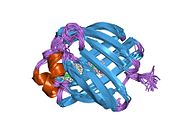How Can We Help?
Retinol-binding protein 2 (RBP2) is a protein that in humans is encoded by the RBP2 gene.[5][6][7]
Function
RBP2 is an abundant protein present in the small intestinal epithelium. It is thought to participate in the uptake and/or intracellular metabolism of vitamin A. Vitamin A is a fat-soluble vitamin necessary for growth, reproduction, differentiation of epithelial tissues, and vision. RBP2 may also modulate the supply of retinoic acid to the nuclei of endometrial cells during the menstrual cycle.[7]
References
- ^ a b c GRCh38: Ensembl release 89: ENSG00000114113 – Ensembl, May 2017
- ^ a b c GRCm38: Ensembl release 89: ENSMUSG00000032454 – Ensembl, May 2017
- ^ "Human PubMed Reference:". National Center for Biotechnology Information, U.S. National Library of Medicine.
- ^ "Mouse PubMed Reference:". National Center for Biotechnology Information, U.S. National Library of Medicine.
- ^ Loughney AD, Kumarendran MK, Thomas EJ, Redfern CP (Oct 1995). "Variation in the expression of cellular retinoid binding proteins in human endometrium throughout the menstrual cycle". Hum Reprod. 10 (5): 1297–304. doi:10.1093/oxfordjournals.humrep.a136137. PMID 7657783.
- ^ De Baere E, Speleman F, Van Roy N, Mortier K, De Paepe A, Messiaen L (Mar 1999). "Assignment of the cellular retinol-binding protein 2 gene (RBP2) to human chromosome band 3q23 by in situ hybridization". Cytogenet Cell Genet. 83 (3–4): 240–1. doi:10.1159/000015191. PMID 10072590. S2CID 22941923.
- ^ a b "Entrez Gene: RBP2 retinol binding protein 2, cellular".
Further reading
- van Eijk HG, Tio TH, Bos G (1975). "Iron in skin biopsies". Archiv für Dermatologische Forschung. 251 (3): 245–8. doi:10.1007/BF00561766. PMID 1115525. S2CID 11716439.
- Herr FM, Ong DE (1992). "Differential interaction of lecithin-retinol acyltransferase with cellular retinol binding proteins". Biochemistry. 31 (29): 6748–55. doi:10.1021/bi00144a014. PMID 1322170.
- Aström A, Tavakkol A, Pettersson U, Cromie M, Elder JT, Voorhees JJ (1991). "Molecular cloning of two human cellular retinoic acid-binding proteins (CRABP). Retinoic acid-induced expression of CRABP-II but not CRABP-I in adult human skin in vivo and in skin fibroblasts in vitro". J. Biol. Chem. 266 (26): 17662–6. doi:10.1016/S0021-9258(19)47422-X. PMID 1654334.
- Colantuoni V, Cortese R, Nilsson M, Lundvall J, Båvik CO, Eriksson U, Peterson PA, Sundelin J (1985). "Cloning and sequencing of a full length cDNA corresponding to human cellular retinol-binding protein". Biochem. Biophys. Res. Commun. 130 (1): 431–9. doi:10.1016/0006-291X(85)90435-8. PMID 2992469.
- Demmer LA, Birkenmeier EH, Sweetser DA, Levin MS, Zollman S, Sparkes RS, Mohandas T, Lusis AJ, Gordon JI (1987). "The cellular retinol binding protein II gene. Sequence analysis of the rat gene, chromosomal localization in mice and humans, and documentation of its close linkage to the cellular retinol binding protein gene". J. Biol. Chem. 262 (6): 2458–67. doi:10.1016/S0021-9258(18)61526-1. PMID 3029082.
- Folli C, Calderone V, Ottonello S, Bolchi A, Zanotti G, Stoppini M, Berni R (2001). "Identification, retinoid binding, and x-ray analysis of a human retinol-binding protein". Proc. Natl. Acad. Sci. U.S.A. 98 (7): 3710–5. Bibcode:2001PNAS...98.3710F. doi:10.1073/pnas.061455898. PMC 31117. PMID 11274389.
- Chan SW, Hong W (2001). "Retinoblastoma-binding protein 2 (Rbp2) potentiates nuclear hormone receptor-mediated transcription". J. Biol. Chem. 276 (30): 28402–12. doi:10.1074/jbc.M100313200. PMID 11358960.
- Zhang L, E X, Luker KE, Shao JS, Levin MS, Suh E, Li E (2002). "Analysis of human cellular retinol-binding protein II promoter during enterocyte differentiation". Am. J. Physiol. Gastrointest. Liver Physiol. 282 (6): G1079–87. doi:10.1152/ajpgi.00041.2001. PMID 12016134. S2CID 21279637.
External links
- PDBe-KB provides an overview of all the structure information available in the PDB for Human Retinol-binding protein 2 (RBP2)






Recent Comments